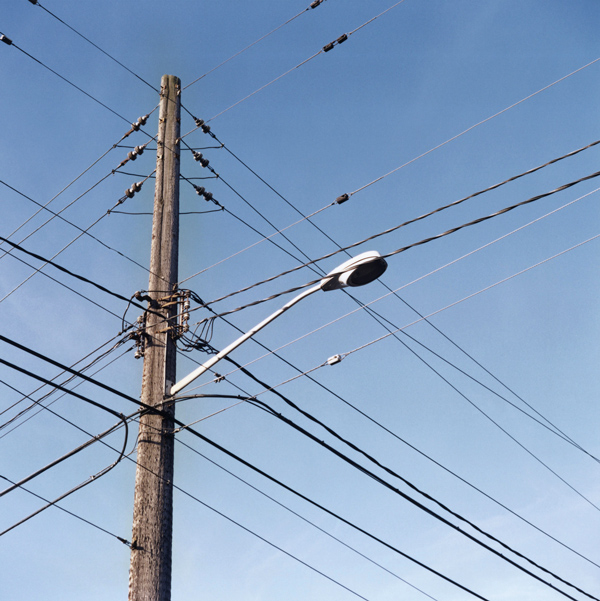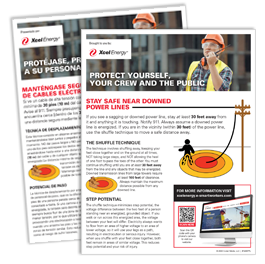Look up and Live—Power Line Safety
Contacting an overhead power line could cost you your life.
Overhead power lines are not insulated. So if you touch one with your body, your equipment, or your tools, you or someone you work with could die. Everyone who works near power lines is at risk, whether you operate heavy equipment or use ladders and handheld tools. It’s up to you to work safely to protect yourself, your crew and the public.
Look out for power lines:
- Search carefully for overhead power lines, poles and guy wires. Conditions can easily change, so check the site frequently.
- Look for lines that may be blocked from view by trees or buildings. If you suspect hidden power lines, talk to the utility company, inspectors and experienced colleagues about your concerns.
- To learn the location of underground utilities, call the local one-call utility locator service.
Alert others about lines at your pre-job briefing.
Make sure everyone at the job site knows about nearby overhead and underground utilities and where they are located. Whether they are operating heavy equipment, using handheld tools or climbing ladders, all workers on site must be aware of power lines.
Assume all lines are energized and potentially dangerous.
This includes overhead and underground lines, and the service drops that run from utility poles to buildings.
Before any work begins, make time to examine the work site carefully for overhead utilities.
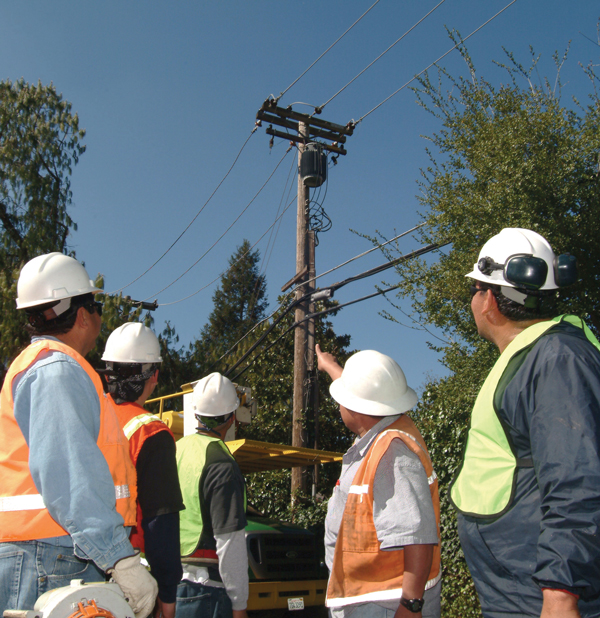
Shocking fact:
Almost 200 construction workers die each year in the United States from contact with electrical energy, the fifth-leading cause of workplace death. Direct or indirect contact with power lines is the most common cause of electrocution according to the Occupational Safety and Health Administration.
When working with ladders or long tools:
Stay at least 20 feet away from all overhead power lines.
When cranes or derricks are used in construction:
Keep the crane boom and load at least 20 feet away from the line if you don’t know the line’s voltage. Always assume the line is energized, and allow nothing closer than 20 feet unless you have confirmed with the utility owner/operator that the line has been deenergized.
As voltage increases, clearance distances also increase.
Contact your local utility and consult the OSHA regulations at www.osha.gov for specific safety clearance requirements.
Clearly mark boundaries.
Use tape, signs or barricades to keep workers and equipment the required distance away.
If you are in doubt about line voltages, clearance requirements or how to work safely near power lines, contact the local electric utility.
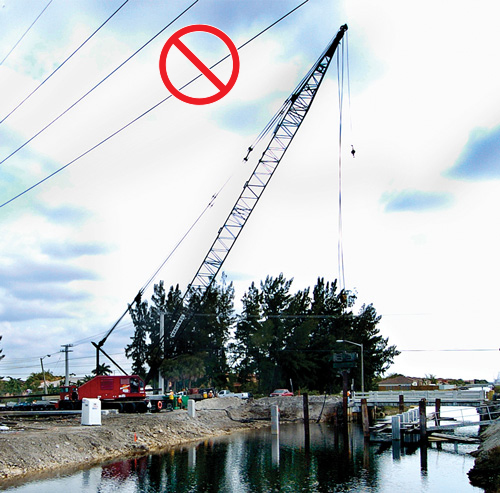
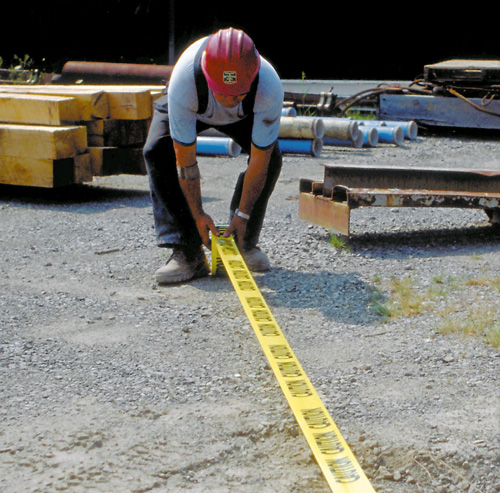
Shocking fact:
You can use tape, signs or barricades to maintain the required distance from power lines. Make the barriers portable enough so they can be easily changed to keep up with changes in the job.
For equipment operators, visibility is limited.
When you operate hoisting equipment, it is often hard to judge the distance from your equipment to power lines overhead. Certain weather conditions and bright or dim lighting can make it even harder to see.
A spotter helps you stay clear of overhead lines.
Someone on the ground has a much better view of the power lines near you. You should work with a dedicated spotter on the ground whose only job is to watch your equipment and make sure you stay a safe distance from overhead lines and other hazards.
Crane and derrick operators:
Maintain continuous contact with a dedicated spotter to comply with electric line clearance requirements. Make sure your spotter is not doing double duty by spotting and guiding a load at the same time.
A dedicated spotter on the ground should be stationed to watch that your equipment stays away from power lines.
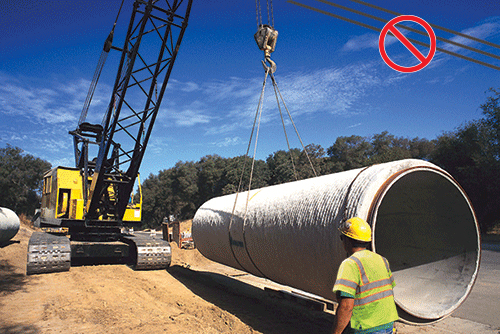
Shocking fact:
Construction workers in Manhattan don’t have to worry about contacting overhead power lines. A court order decades ago required that all power lines must be underground for safety reasons. Since then, many other large downtown areas have followed suit.
When you guide a load, you are at risk of electric shock.
If the crane or other piece of equipment you are guiding hits an overhead power line, electricity can travel down the tag line that you are holding and through you. In the event of power line contact, workers on the ground are in the greatest danger of shock.
Don’t try to guide a load and spot at the same time.
Assign a spotter whose only job is to make sure the equipment stays clear of power lines. Spotting effectively needs someone’s full attention.
When you guide a load, have a spotter who can alert you if equipment gets too close to power lines. Your life could depend on it.
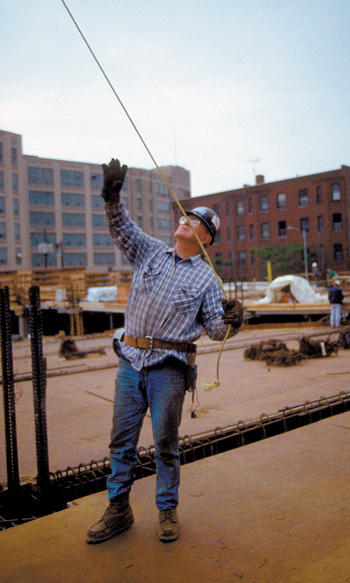
Shocking fact:
A worker was electrocuted while pulling a wire rope attached to a crane cable. The cab of the crane was positioned about 11 feet from a 7,200-volt power line. The crane operator swung the crane boom and cable toward the victim, and the momentum of the swinging crane apparently caused the crane cable to contact the power line.
Keep vehicles clear of lines.
Long-bed dump trucks, concrete pumping rigs and other high-rise equipment can contact overhead power lines. Make sure you know the required safe work distances and encroachment prevention precautions for all power lines at your job site, and respect all marked safety boundaries. Work with a dedicated spotter to comply with line clearance requirements.
Take care with ladders and long handheld tools.
Carry ladders, paint rollers rain gutters, and other long objects so they are parallel to the ground. When it’s time to use them, raise and lower them carefully to avoid power lines.
Adjust ladders and tools cautiously.
Before adjusting extension ladders, paint rollers or other long tools, add your own height and make sure the total height will remain a safe distance of at least 20 feet away from all overhead power lines. As voltage increases, clearance distances also increase. Consult your local utility and the OSHA regulations at www.osha.gov for specific safety clearance requirements.
Carry long equipment parallel to the ground, and adjust tools carefully to maintain the required safety clearance from power lines.
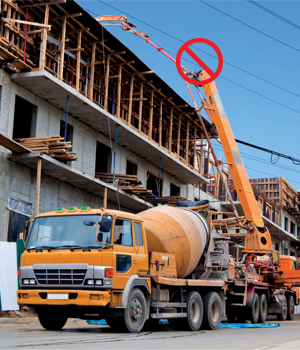
Shocking fact:
When climbing a single or extension ladder, you should never stand above the third rung from the top of the ladder or above the point where the ladder touches the wall or ledge.
Steer clear of power lines:
- Ask your utility company to identify power lines in the area and familiarize yourself with their location.
- Store wheeled irrigation equipment at least 100 feet from power lines, and keep irrigation pipe at least 20 feet away from all overhead power lines. (Higher voltages require larger clearances.)
- When installing above ground irrigation systems, keep pipes horizontal so you don’t lift them into lines by mistake.
Adjust spray to avoid shock hazards.
Sprinkler streams from an irrigation system should break into droplets as opposed to flowing in a single unbroken stream. An unbroken stream of water that contacts a power line can conduct electricity and cause a dangerous shock.
Keep irrigation pipe at least 20 feet away from all overhead power lines. Higher voltages require greater clearances.
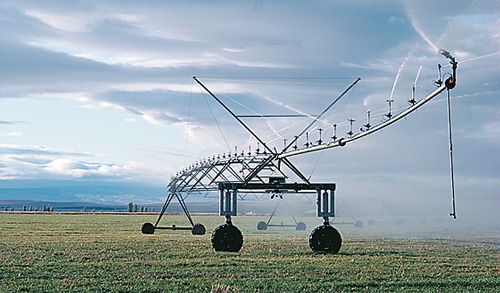
Shocking fact:
Many farms have no power lines running over their fields, but certainly have them present in equipment and grain storage areas. When transporting irrigation equipment, be sure the paths between the storage areas and the fields are safe routes.
Stay far away from downed lines:
- Even if they don’t hum, spark or “dance,” downed lines can be dangerous.
- If you see one, carefully move away from the line and anything it is touching. Instruct others in the area to do the same.
- Call 911 and the electric company to report the line.
- Downed lines are most common after storms and high winds. If you are outside after a storm, be alert for lines that may be obscured by streams or standing water.
Shuffle, don’t run, from a downed line.
The correct technique for moving away from a downed line is to shuffle with your feet together and on the ground. Fight the urge to run, and warn others not to run. This is because when a live wire touches the ground, electricity travels through the ground in all directions. Voltage decreases as it travels from the center where the live wire is touching the ground. If you run or take large steps, you increase the chance that electricity could come up one leg and go out the other, and you could be shocked.
If a line is downed near you, shuffle away with small steps so you don’t get shocked. Warn others to do the same.
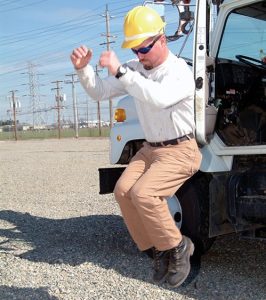
Shocking fact:
It is a myth that rubber tires provide insulating protection from a downed power line when you are inside a vehicle. Most tires actually contain steel sidewalls and belts. So it is the metal around the car and in the tires that conducts the electricity from the power line into the ground and keeps you safe—if you stay inside the car.
Click here to view additional information about staying safe near downed power lines.
Stay away.
Stay clear of any person or any object that is in contact with a power line. Call 911 and the electric company immediately. Don’t try to rescue the victim. Stay away until rescue workers assure you the power has been turned off.
Protect yourself.
If you touch someone who is in contact with electricity, you could be shocked too. You can also be shocked if you touch the vehicle or equipment that person is in, or the tool they are holding. Again, the best thing to do is to stay far away and call for help.
Immediately call 911 and the electric company if someone accidentally contacts a power line. Don’t try to help the victim until you’re sure the power is off.
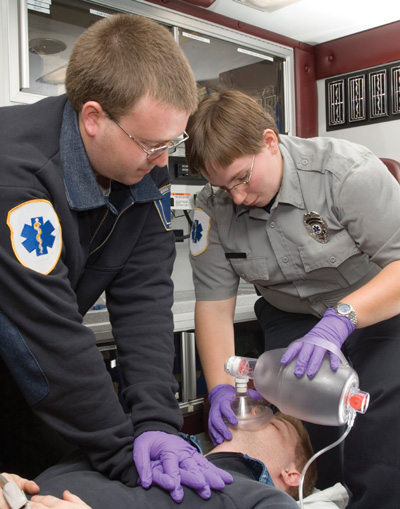
Shocking fact:
It’s human nature to want to help someone who is being hurt. But when a power line is involved, you can’t help without endangering yourself. Do not try to use nonconductive ropes or tools to push an electrical contact victim clear of a power line—power line voltages can be strong enough to travel through nonconductive objects.
If there is no immediate danger, take these steps:
- Move the equipment away from the line if you can do so safely.
- Have someone call 911 and the electric utility right away.
- Stay on the equipment until rescue workers say it is safe to get off.
- Warn others away. When equipment hits a line, workers standing on the ground are in the greatest danger.
If you MUST get off the equipment due to fire or other danger, fold your hands across your chest and jump clear.
Land far enough away from the equipment that you don’t touch the equipment and the ground at the same time. Land with your feet together and shuffle away, keeping your feet together and on the ground.
If your equipment touches a power line, wait on the equipment until rescue workers arrive. If you must get off, fold your hands across your chest and jump clear without touching the equipment and the ground at the same time, and shuffle away.
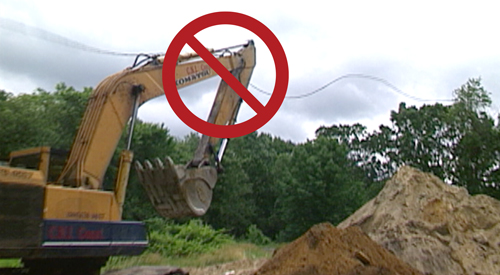
Shocking fact:
Even after you’ve jumped from equipment with a power line on it, the danger may not be over. Electricity can spread out through the ground in all directions from any downed line. The voltage drops as you move away from the point of contact. However, if you touch a high-voltage and a low-voltage zone at the same time (which can happen if you take big steps or run), electricity can travel up one leg and down the other, and you can be shocked. This is why you should shuffle away from the line with small steps, keeping your feet close together and on the ground at all times.

